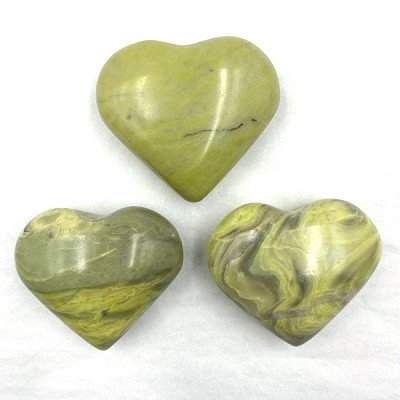
Serpentine is not a single mineral, but rather a group of related minerals. Besides for the main members of Antigorite and Chrysotile, a distinction is not usually made between the individual members except under scientific study and classification. Antigorite usually represents the more solid forms, and Chrysotile usually represents the fibrous forms, especially asbestos. Chrysotile is further sub-classified into four member minerals by its crystallization, and Clinochrysotile is by far the most prevalent form of Chrysotile.
Fibrous Chrysotile, a type of asbestos, should never be brought near the mouth. If its fibers or particles enter the lungs, they can cause asbestosis. Asbestosis is a lung disease caused by inhalation of asbestos particles, which causes several cancers, particularly lung cancer and mesothelioma. Symptoms of asbestosis do not arise until about 20 years after the inhalation. Due to the hazards, washing hands after handling specimens is highly recommended. Many mineral collectors avoid collecting asbestos minerals out of safety concerns. Serpentine is a very common mineral, and is found in abundance worldwide. Some famous localities include The Lizard Peninsula, Cornwall, England (the type locality of Lizardite; the Antigorio Valley, Piedmont, Italy (the type locality of Antigorite); and Mount Olympus, Cyprus. The Jeffery Asbestos Mine in Richmond Co., Quebec, is the one of the most productive asbestos mines, providing great amounts of Chrysotile. Thetford, in Megantic Co., Quebec has also produced fine Chrysotile.
In the U.S., large amounts of Serpentine come from Fresno, Calaveras, San Benito, Mariposa, and Toulumne Cos., California; and Gila Co., Arizona. East Coast localities include Montville, Morris Co., New Jersey; Hoboken, Hudson Co., New Jersey; Antwerp, Gouverneur, and Balmat; St. Lawrence Co., New York; and Staten Island (Richmond Co.), New York. In the old Tilly Foster Mine, Brewster, Putnam Co., New York, many minerals were replaced by Serpentine, resulting in the Serpentine having very interesting crystal forms. The Wood's Chrome Mine in Texas, Lancaster County, Pennsylvania is a classic mine famous for both its Williamsite and a rare purple form of Antigorite that came from there. Other important occurrences are the Cedar Hill Quarry, Lancaster Co., Pennsylvania (especially the Picrolite variety); Easton, Northampton Co., Pennsylvania; and the Belvidere Mountain Quarries (Eden Mills), Orleans/Lamoille Counties, Vermont.
Below is a locality list for individual Serpentine members:
Amesite is found in Chester, Hampden Co., Massachussetts. It also occurs in Dufek massif, in the Pensacola Mountains, Antarctica; and is especially noted in Sarany in the Ural Mountains, Russia, for a rare purple variety. Cronstedtite is found in Salsigne, France; the Brunita Mine, La Union, Spain; Pribam, Bohemia, Czech Republic; and the Herja Mine, Baia Mare, Romania. It also occurs in Wheal Maudin and Wheal Jane, Cornwall, England; Congonhas de Campo, Minas Gerais, Brazil; and in Llallagua, Bolivia. Fraipontite is found in Challacollo, Chile; Vielle-Montague, Belgium and in the Silver Bell mine, Gleeson, Cochise Co., Arizona. It is often an alteration product of Smithsonite. Nepouite is found in the Nepoui Mine in New Caledonia. It is also found in the 132 North nickel mine, Widgiemooltha, Western Australia; in Letovice, Czech Republic; in Callenberg, Saxony, Germany; and in the Wood's Chrome Mine, Texas, Lancaster County, Pennsylvania. Nepouite is an important ore of nickel. It is often called Garnierite, but that is not its proper scientific name. Like many other stones, the serpentine gem comes in a range of colours. Green serpentine is the most widely known version. It's available in a range of shades. You can find serpentine stones in lime, mint, kelly, forest, and many more green hues. There are also pieces of green serpentine that have an earthy tinge, leaning into olive or moss territory.
With green serpentine, some degree of mottling, banding, or striating is normal. In many cases, the variations are other shades of green. However, you can also find pieces with cream, brown, or white markings.
Serpentine can come in hues other than the traditional green, as well. Blue serpentine is incredibly striking, usually coming in shades close to denim or navy. Often, those pieces are either striped or mottled, featuring either a range of blues or segments of white, gray, or cream.
In some cases, blue and green serpentine are found in a single stone, with clear boundaries between each hue. At times, the blue and green shades blend, creating an ombre effect. Additionally, there can be intermediate blue-green serpentine gemstones.
There's also red serpentine. This version of the serpentine stone tends to come in deeper, earthier shades, like brick, maroon, or mahogany. It can also feature mottling or banding, often in shades of white, beige, or gray.
Credit - minerals.net. fiercelynxdesigns.com. naturesexpression.com
Congratulations @foarsyad! You have completed the following achievement on the Hive blockchain And have been rewarded with New badge(s)
Your next target is to reach 7000 upvotes.
You can view your badges on your board and compare yourself to others in the Ranking
If you no longer want to receive notifications, reply to this comment with the word
STOPCheck out our last posts:
Support the HiveBuzz project. Vote for our proposal!